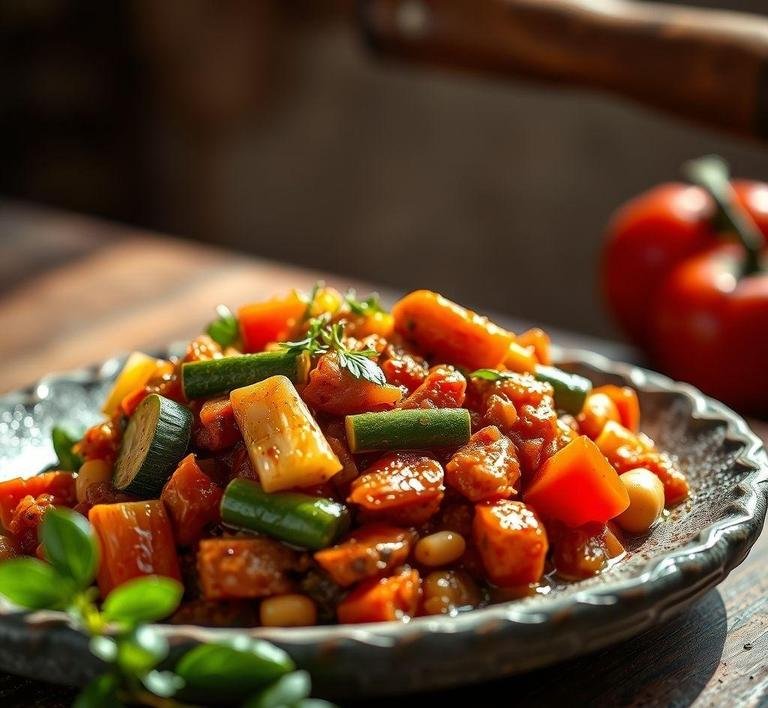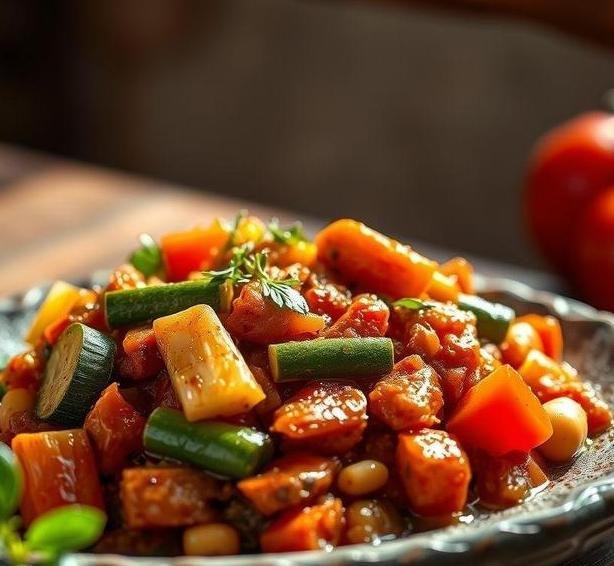Mary Berry’s Veggie Ragu is a rich, tomato-based vegetable stew that bursts with rustic flavor and comforting aromas. This recipe is one of Mary’s brilliant ways of showing that vegetarian food can be just as satisfying and soul-warming as any meat dish. It draws from the essence of traditional Italian ragù-a slow-cooked sauce typically made with minced meat-but replaces the meat with a bounty of vegetables for a healthier, vibrant twist.
Her veggie ragu is layered with tender chunks of mushrooms, courgettes, peppers, and lentils, all simmered gently in a herbed tomato sauce until every bite is infused with deep, savory richness. It’s a versatile dish too-serve it with pasta, pile it onto baked potatoes, spoon it over polenta, or enjoy it simply with crusty bread.
It’s the kind of recipe that fills the house with warmth, both in aroma and atmosphere. And while it may be simple to prepare, the result is something profoundly satisfying.
Mary Berry’s Veggie Ragu Recipe
Ingredients Needed

Let’s take a closer look at what you’ll need to whip up this robust and hearty veggie ragu. Mary Berry’s approach is all about balance, so each ingredient plays a key role in building the flavor profile.
Vegetables
- 1 onion, finely chopped – the aromatic base.
- 2 garlic cloves, crushed – adds that essential depth.
- 2 courgettes (zucchini), diced – soft, tender, and subtly sweet.
- 1 red pepper, deseeded and chopped – for sweetness and color.
- 1 yellow pepper, deseeded and chopped – adds vibrancy.
- 200g chestnut mushrooms, chopped – earthy, meaty texture.
Other Ingredients
- 2 tablespoons olive oil – for sautéing and flavor.
- 400g can of chopped tomatoes – the base of the sauce.
- 2 tablespoons tomato purée – for richness and concentrated flavor.
- 1 teaspoon sugar – to balance the acidity of tomatoes.
- 150ml vegetable stock – brings everything together and adds depth.
- 400g can of green or brown lentils, drained – hearty and protein-packed.
- 1 teaspoon dried mixed herbs – think oregano, thyme, and basil.
- Salt and freshly ground black pepper, to taste.
- Fresh basil, to garnish (optional but recommended).
Equipment Needed
This dish doesn’t require fancy gadgets or appliances. In fact, part of its charm is how unfussy it is.
Kitchen Essentials
- Large saucepan or sauté pan – wide enough to allow your vegetables to cook evenly.
- Wooden spoon or spatula – for stirring.
- Chopping board and sharp knife – for prepping all the fresh vegetables.
- Measuring jug – especially for your stock.
- Can opener – unless you’ve got the easy-open tins.
Optional but helpful:
- Garlic press – if you want to crush your garlic quickly.
- Herb scissors – for a neat basil garnish at the end.
Instructions To Make Mary Berry’s Veggie Ragu
Ready to cook? Here’s a step-by-step walkthrough to bring this delicious ragu to life. It’s incredibly straightforward but yields complex flavors with minimal effort.
Step 1: Prep Your Ingredients
Begin by chopping all your vegetables into bite-sized pieces. This helps everything cook evenly and meld together beautifully.
Step 2: Sauté The Aromatics
Heat the olive oil in your large saucepan over medium heat. Add the chopped onion and cook gently for about 5 minutes until soft and translucent. Stir in the garlic and cook for another minute until fragrant.
Step 3: Add The Vegetables
Toss in the courgettes, mushrooms, and peppers. Cook for around 5-7 minutes, stirring occasionally, until they begin to soften and take on some color.
Step 4: Build The Sauce
Stir in the chopped tomatoes, tomato purée, sugar, and mixed herbs. Pour in the vegetable stock and season generously with salt and pepper. Bring everything to a gentle simmer.
Step 5: Simmer Slowly
Cover and simmer for about 20-25 minutes, stirring occasionally, until the vegetables are tender and the sauce has thickened slightly. This slow cooking allows all the flavors to deepen and mingle.
Step 6: Add The Lentils
Finally, add the drained lentils to the pan. Stir well to incorporate them into the sauce and let everything simmer for another 5 minutes so the flavors combine.
Step 7: Garnish And Serve
Taste and adjust seasoning if needed. Spoon the ragu onto plates, sprinkle with fresh basil, and serve with your favorite accompaniment-pasta, rice, or just a big wedge of warm bread.
Tips And Tricks
Want to elevate your veggie ragu to superstar level? Here are a few insider secrets and creative tips to keep in your apron pocket:
- Use fresh herbs if you have them. A handful of fresh thyme, oregano, or basil stirred in at the end will really lift the flavors.
- Add a splash of red wine during the sautéing stage for added richness-just simmer off the alcohol before adding the tomatoes.
- Don’t overcook the vegetables. You want them tender, not mushy, so keep an eye during the simmering stage.
- Want a thicker texture? Blend a small portion of the ragu (just a few ladles) and stir it back into the pot.
- Make it spicy by adding a pinch of chili flakes or a dash of hot sauce if you prefer a bit of heat.
- Let it rest. Like a good stew, this ragu tastes even better the next day, so consider making it ahead and reheating.
- Freeze it! This ragu freezes beautifully. Portion it into containers, label, and freeze for up to 3 months.
Mary Berry’s Veggie Ragu is more than just a meatless meal-it’s a celebration of vegetables, simplicity, and homely goodness. It’s the kind of recipe that comforts, nourishes, and brings people together around the table. Whether you’re a lifelong vegetarian or just looking to cut back on meat without sacrificing flavor, this dish ticks all the boxes. With its tender vegetables, rich tomato base, and satisfying lentils, it’s a beautiful marriage of flavor and wholesomeness.
So grab your chopping board, crank up the stove, and let the humble veggie ragu transport you to a cozy Italian kitchen-Mary Berry style.
Easy Recipe Variations For Mary Berry’s Veggie Ragu

Mary Berry’s Veggie Ragu is already a comforting, vegetable-laden delight. It balances the earthy sweetness of slow-cooked vegetables with the richness of tomato and the subtle perfume of herbs like thyme and bay. But the beauty of this dish is how forgiving and versatile it is. You can tweak it endlessly to match what’s in your fridge, your dietary needs, or just your mood.
1. Protein-Boosted Ragu
While the original is a vegetarian masterpiece, you can easily sneak in some plant-based protein for a more filling, balanced meal. Toss in a can of lentils-brown or green hold their shape best-for a fiber-rich upgrade. Chickpeas or cannellini beans also bring a creamy contrast to the robust sauce.
2. Mushroom Magic
If you’re craving a deeper umami flavor, swap out some of the standard veggies for a medley of mushrooms. Portobello, chestnut, and shiitake mushrooms mimic the meatiness of traditional ragu and absorb the sauce beautifully. A splash of soy sauce or tamari deepens that savory note even further.
3. Mediterranean Twist
Fancy something a little sunnier? Add chopped olives, a sprinkle of capers, and a touch of orange zest to the sauce. Swap basil for rosemary or oregano, and consider stirring through some grilled aubergine or courgette toward the end for a Southern European vibe.
4. Creamy Comfort
For a luscious, creamy variation, stir in a spoonful of mascarpone or ricotta just before serving. It turns the ragu silky and indulgent-perfect over soft polenta or pillowy gnocchi. You could also blend part of the sauce to create a thicker, velvet-smooth consistency without any cream at all.
5. Spice It Up
If your palate enjoys a kick, a few chili flakes or even a diced fresh red chili can turn up the heat. Add it when you sauté your onions and garlic so the oil gets infused. For a smoky twist, paprika (especially the smoked Spanish variety) adds depth and drama to each spoonful.
Storing Leftovers
Veggie ragu isn’t just a "cook once, eat once" dish-it’s the gift that keeps on giving. In fact, it often tastes better the next day as the flavors deepen and meld.
1. In the Fridge:
Allow the ragu to cool completely before storing it in an airtight container. It will keep beautifully in the fridge for up to 4 days. Make sure to reheat thoroughly on the stove or in the microwave until piping hot before serving again.
2. In the Freezer:
Veggie ragu freezes like a dream. Portion it out into freezer-safe containers or heavy-duty freezer bags (lay them flat for easy stacking) and freeze for up to 3 months. Label with the date to keep track. Thaw overnight in the fridge or reheat straight from frozen in a pan with a splash of water to loosen it.
Pro Tip:
If you’re planning to freeze it, avoid adding any dairy (like mascarpone or cream) before freezing. Instead, stir it in fresh when reheating for the best texture.
What To Eat With Mary Berry’s Veggie Ragu?
This dish is hearty enough to stand on its own, but pairing it with the right companion can turn your dinner into a complete culinary experience. Think textures and contrasts-creamy, crusty, chewy, or bright.
1. Pasta
Of course, the classic pairing! Wide noodles like pappardelle, rigatoni, or tagliatelle really hold onto the sauce, making every bite rich and flavorful. Or try whole-wheat or lentil-based pasta for a health-conscious option that adds extra fiber.
2. Creamy Polenta or Mash
A scoop of creamy polenta or a velvety mashed potato base turns this ragu into the ultimate comfort food. The smoothness of the mash balances beautifully with the chunky texture of the ragu.
3. Crusty Bread
Warm, crusty bread-ciabatta, sourdough, or even garlic bread-makes an irresistible vehicle for scooping up that thick, rustic sauce. Bonus points for toasting it with a drizzle of olive oil and a rub of garlic.
4. Rice or Grains
Serve the ragu over brown rice, quinoa, or bulgur for a hearty grain bowl. These grains soak up the sauce while adding a chewy texture and a wholesome base. Farro, with its nutty bite, is an especially good match.
5. A Fresh Salad
Balance out the richness with something crisp and refreshing. A peppery rocket salad with lemon vinaigrette, or a fennel and orange salad, brings brightness and contrast to your plate.
6. Cheese, Glorious Cheese
A final flourish of freshly grated Parmesan (or a vegetarian hard cheese) lifts the ragu to another level. Or go bold with a crumble of feta or a dollop of burrata if you’re feeling indulgent.
Conclusion
Mary Berry’s Veggie Ragu is more than just a dish-it’s a canvas for creativity and comfort. Whether you stick to her original version or venture into new territory with your own twist, it’s a dish that invites you to savor the process and the results. From its deeply savory, herb-laced aroma to the way it hugs your pasta, this ragu offers that rare balance of simplicity and depth that makes it a true staple.
And let’s not forget the practical side-this is a meal that loves to be made ahead, stored, frozen, reheated, and reinvented. It’s the kind of recipe that becomes a regular in your kitchen rotation because it adapts so well to every need and craving.
So the next time you find yourself with a crisper drawer full of veg, or you’re craving something hearty and wholesome, you’ll know exactly what to do. Ladle up some love with Mary Berry’s Veggie Ragu-and make it your own.
FAQs
What Vegetables Are Included In Mary Berry’s Veggie Ragu Recipe?
Mary Berry’s veggie ragu features a variety of vegetables including onions, carrots, celery, mushrooms, and bell peppers. These vegetables are sautéed to build the flavor base before being simmered in a rich tomato sauce. You can also add courgettes (zucchini) or aubergines (eggplants) for extra texture and flavor.
Can I Make Mary Berry’s Veggie Ragu Recipe Vegan?
Yes, Mary Berry’s veggie ragu can easily be made vegan by swapping out any non-vegan ingredients, such as replacing butter with olive oil or a plant-based spread. For the ragu’s richness, vegetable stock can be used in place of any meat stock. Make sure to check any pre-made ingredients like pasta to ensure they are vegan-friendly.
How Long Does It Take To Cook Mary Berry’s Veggie Ragu?
Mary Berry’s veggie ragu typically takes about 30-40 minutes to prepare and cook. This includes the time needed to chop and sauté the vegetables and then simmer the ragu to develop the flavors. You can also let it cook for a bit longer on low heat to deepen the flavors if you have extra time.


